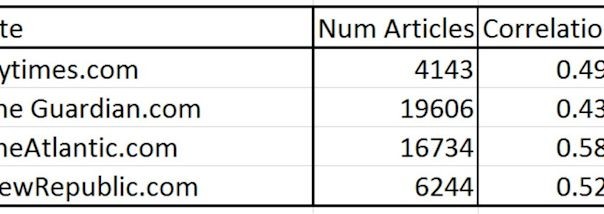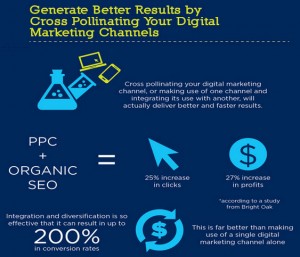Having trouble gaining traction through your content marketing efforts? Columnist Eric Enge suggests focusing your content marketing strategy around what he calls “anchor content.”

Content marketing is a growing part of many business’ strategy, but for many, it proves difficult to do successfully. In today’s post, I’m going to explore why that’s the case, and I’ll give you some ideas on what you can do about it.
Background
To start with, the articles linked in this sentence can provide you with a solid grounding in how content marketing works, as well as how you can get started. That’s all well and good, but it does turn out that there is more to it.
To understand why, it’s also very useful to understand the concepts set forth by Mark Schaefer in his classic piece, “Content Shock: Why content marketing is not a sustainable strategy.” In it, he lays out the core of the problem: So many people are publishing content now that it’s a major struggle to gain the attention of your target audience.
In short, simply creating garden-variety content isn’t going to cut it: It’s likely that hundreds of people will have covered it before you did.
Digging In Deeper: Industry Studies About Content Sharing & Getting Links
There have been some great studies on what drives social sharing and how it correlates to other activities. For example, Chartbeat did a study to see if people actually read the articles they share in social media.
You can see the results summarized in this chart:

The yellow, red and orange data points are the ones that represent the highest number of articles, and you can see that they get near zero social sharing. As you move toward the lower right quadrant of the chart, you can see the articles that get high read time. There are a fair number of articles here, but as you can see, they don’t tend to get a ton of social sharing.
In the top left quadrant, we see articles with very high social sharing. There are some articles that get these, but this group represents content with low read time.
Finally, we have the top right quadrant, which looks nearly empty. This is where the articles that get both high read time and high social sharing go.
You might think you should then focus on obtaining a high number of social shares, but the problem is that these types of articles are unlikely to generate lots of engagement and value for your brand.
In addition, in September of 2015, Steve Rayson of BuzzSumo published an article on the Moz blog called “Content, Shares, and Links: Insights from Analyzing 1 Million Articles.” This article focused on the correlation between social shares and links. From that study, here is a view of the problem of getting attention:

As you can see, most posts accomplish nothing: no links and no material social shares. BuzzSumo and Moz further dug in to analyze the correlation between social shares and obtaining links to your content. What they found was that there is very little correlation at all:

This analysis made use of Pearson Correlation Coefficients, where a perfect correlation would be +1, a perfect negative correlation would be -1, and no correlation at all would be 0.
For purposes of reading the above chart, a value of +0.3 or greater represents a material level of correlation. However, in the BuzzSumo data, the correlation between shares and links was only +0.011, or pretty close to no correlation at all.
So far, what these two studies tell us is that social shares don’t really seem to correlate with anything. They also tell us how hard it is to get any attention out there.
But there are some glimmers of hope that emerge from a deeper dive into the BuzzSumo/Moz analysis. For example, these sites do very well at getting both shares and links:

One of the things these sites are really well known for is their opinion-forming journalism. However, they are also extremely authoritative, and that reputation certainly helps get visibility for their articles. (Keep in mind, however, that visibility and getting links are not the same thing.)
In addition, here are some other sites that appear to show a strong correlation:

These sites are well-known for publishing data-driven studies. People love data, and my own experience with data-driven stories is that they do indeed draw lots of links and social shares.
One more major correlation of interest that leapt out at me from the study:

You can see above that posts with between 1,000 and 2,000 words gained the most shares and links. So content length matters somewhat, too.
Take care not to treat this as an artificial goal or constraint, though. If your piece is going to require 2,500 words to write properly, or you’ve covered it all in 500 words, so be it. Don’t force it.
Enter Anchor Content
Looking at this data and based on my own experiences, what I’ve seen is that it’s critical to produce what I call “anchor content.” You need to find a way to create pieces of content that are clearly differentiated from the other content that’s available in your market space.
Seth Godin did a TED Talk, all the way back in 2003, in which he spoke about being remarkable. Some key concepts covered in that linked video are important to internalize, and I’ll adapt those here to content marketing:
- Focus your content on topics of interest to the early adopters and innovators in your space. They are the ones who are most likely to spread it.
- Promote your content to people who are listening. Your mass market isn’t listening, so there is no point attempting to address them.
- In Seth’s terms, “very good is bad,” and he’s right. You need to focus your attention on creating content that it excellent, elite, and yes, remarkable.
The notion of being remarkable is an interesting one, as it gets across the concept of being “worth talking about.” You need to produce content that opinion leaders will find worth talking about (or sharing or linking to).
That’s what I call “anchor content,” and it needs to be the foundation of any content marketing strategy, or chances are you’ll fail.
A common mistake people make when they first enter into a content marketing effort is focusing on how much content they should plan on producing. That’s not the right focus. You need to work on establishing yourself with a series of anchor-content-level pieces. Once you’ve established yourself with that level of content, you will need to keep finding ways to come up with more of it over time.
So how much content is enough? It depends on your market, but in many markets, one anchor piece a quarter may well be enough.
As your reputation grows, you will find that you can start to produce more mundane pieces of content also, but only as a supplement to your ongoing anchor content efforts. When you reach this point, these simple pieces of content will still get good visibility, shares and links.
But it all starts with that foundation: anchor content.
Some opinions expressed in this article may be those of a guest author and not necessarily Marketing Land. Staff authors are listed here.
(Some images used under license from Shutterstock.com.)
Marketing Land – Internet Marketing News, Strategies & Tips
(93)
Report Post







